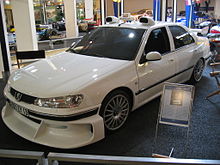Taxi (1998)
| Movie | |
|---|---|
| German title | taxi |
| Original title | taxi |
| Country of production | France |
| original language | French |
| Publishing year | 1998 |
| length | 86 minutes |
| Age rating | FSK 12 |
| Rod | |
| Director | Gérard Pirès |
| script | Luc Besson |
| production | Luc Besson Laurent Pétin Michèle Pétin |
| music | Akhenaton |
| camera | Jean-Pierre Sauvaire |
| cut | Véronique Lange |
| occupation | |
| |
| synchronization | |
| |
| chronology | |
|
Successor → |
|
Taxi is a 1998 action comedy directed by Gérard Pirès based on a script by Luc Besson . The film had four sequels and a US remake called New York Taxi .
action
Daniel works as a taxi driver in Marseille . His real calling, however, is car racing. After a fast ride with the passenger Emilien, a police officer, he is faced with the choice of losing his driver's license or serving the law enforcement officer as a chauffeur for a month. Together, the two set out to put the dreaded Mercedes gang, a gang of German bank robbers, to an end. Not only Daniel's driving skills come to their aid , but also his former colleagues from the pizza delivery service .
criticism
“An extremely successful comedy in France, the dialogues of which are drowned in jokes and senseless verbosity in German dubbing. The attempt to deal with virulent feelings of inferiority ultimately fails because slapstick is confused too much with destructiveness. "
Grossing results
The production costs of the film amounted to 8.1 million euros. Taxi was able to bring in around 44.5 million dollars (≈ 36.1 million euros) worldwide.
Awards
When the Césars were awarded in 1999, Taxi was nominated in seven categories. While the prize for the best French production of the previous year went to Erick Zonca's drama Love for Life , film editor Véronique Lange and the two sound designers Vincent Tulli and Vincent Arnardi won the awards. The nominees were director Gérard Pirès, the film music by Akhenaton and Marion Cotillard and Samy Naceri as the best young actor.
Effect technique
Eight vehicles were used to represent the taxi, each of which served a different purpose. Cars 1 and 2 had neither engine nor seats, but hydraulic technology with 100 m cable. It was used to film the scenes in which Daniel converts his taxi into a racing car at the push of a button. Vehicles 3 and 4 were equipped without spoilers or tuning and were used in the scenes with normal city driving. The vehicles were also equipped with sophisticated technology such as microphones and camera frames. Taxi numbers 5 and 6 were used only for racing scenes in the city or on the highway. The Peugeot 406 3.0 24V used actually have a top speed of approx. 240 km / h. In addition, the cars 5 + 6 did not have a catalytic converter or silencer on the exhaust , in order to make the sound as extreme as possible. However, in the episodes mostly rally cars, especially the Peugeot 306 GTI EVO II Rally Car and its predecessor, are used as sound generators (hence the four-cylinder sound). The remaining two cars were largely used to procure spare parts, as damage to the body was repeatedly caused during the shooting.
In addition, several Mercedes-Benz 400 E were used. The vehicles were redesigned to look like the Mercedes-Benz 500 E. Several vehicles were destroyed during the filming, the replenishment would have been difficult due to the lower number of existing Mercedes-Benz 500 E. The significantly lower price of the Mercedes-Benz 400 E also saved the budget. The rear wings were not standard on either model.
Sequels
The film has been followed by four sequels so far, the first three of which were directed by Gérard Krawczyk . With the exception of Taxi 5 , Samy Naceri and Frédéric Diefenthal each played the leading roles.
Web links
- Taxi in the Internet Movie Database (English)
- Taxi in the online film database
- Taxi in the German dubbing file
Individual evidence
- ↑ Taxi. In: Lexicon of International Films . Film service , accessed March 2, 2017 .
- ↑ http://www.jpbox-office.com/fichfilm.php?id=3040
- ↑ https://www.imdb.com/title/tt0152930/awards?ref_=tt_ql_op_1
